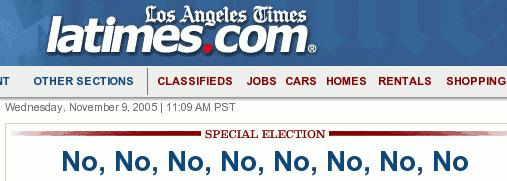The Los Angeles Times website had an interesting way of describing the results of yesterday’s state election:
It’s hard to believe that all eight propositions failed. Even the four Orange County measures failed. Every item on the ballot in our district was rejected!
On a related note, I still don’t like the voting machines we have in OC. The interface is cumbersome and the display is godawful slow. The controls consist of a dial, which moves the cursor, and a button, which selects the current item.
The display is so slow you can watch it redrawing the title and summary of a ballot item when it highlights it. First the rectangle turns blue, then it redraws the text, line by line, in white. It’s like watching print preview in Word Perfect 5.1 for DOS on a 386. You just don’t see that kind of performance on modern computers unless they’re massively bogged down.
As for trying to use the machine, it’s kind of like entering your name in the high score list on an arcade video game with only a trackball and a fire button. I’m sure they chose it for durability reasons—a touch screen would be much more usable, but much easier to break—and went with the low-powered processor to keep the costs down.
I actually liked the punchcards we had before. It was so much more satisfying to slam down that lever.
